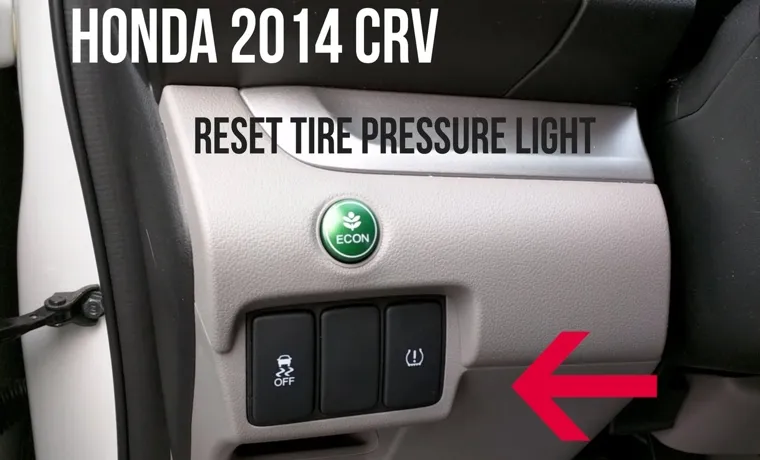Do you always feel puzzled when the low tire pressure warning light illuminates on your Honda Civic’s dashboard? It’s a common problem, and many car owners struggle to reset the tire pressure light after a tire replacement or air pressure adjustment. But don’t worry, it’s not rocket science. With a few simple steps, you can reset the tire pressure light and get back on the road safely.
In this blog post, we’ll walk you through the process of resetting the tire pressure light on your Honda Civic. So, let’s get started!
Table of Contents
Understanding the Tire Pressure Light
If the tire pressure light on your Honda Civic turns on, it is important to address the issue promptly. This light indicates when one or more tires are underinflated, which could lead to poor handling, reduced fuel economy, or even a tire blowing out. To reset the tire pressure light on your Honda Civic, start by checking the tire pressure in all four tires with a gauge.
Inflate them to the recommended pressure, which is typically around 32 PSI for most Honda Civics. Once the tires are properly inflated, press and hold the TPMS reset button, which is located under the steering wheel or in the glove compartment. Hold the button until the tire pressure light blinks twice, indicating that the system has been reset.
Remember to check your tire pressure regularly to prevent this issue from recurring.
Why the Light Comes On
The tire pressure light can be a mystery for many drivers. Why does it come on? What does it mean? Essentially, the tire pressure light is an indicator that your tires may not be inflated properly. This can be due to changes in temperature, normal wear and tear, or even a slow leak in the tire.
It’s important to address this warning as soon as possible, as driving on underinflated tires can lead to reduced fuel efficiency, tire damage, and even unsafe driving conditions. To avoid any confusion, it’s a good idea to keep an eye on your tire pressure regularly and to inflate them to the recommended pressure level. This will prevent the light from coming on unnecessarily and ensure optimal driving performance and safety.

Importance of Maintaining Proper Tire Pressure
Proper tire pressure is vital for maintaining safe driving and tire longevity. The tire pressure light is a crucial indicator of tire health, and often drivers ignore it or don’t realize its significance. This light warns you of any significant changes in tire pressure levels, and it is essential to take immediate action.
Underinflated tires can lead to numerous problems like a loss of fuel efficiency, poor handling, and increased tire wear and tear, which eventually leads to premature tire failure. Overinflated tires, on the other hand, cause a rigid ride and increase the risk of tire punctures. Therefore, keeping track of your tire pressure through consistent tire maintenance, including checking your vehicle’s owner’s manual for the recommended tire pressure levels and regularly checking tire pressure with a tire pressure gauge, can ensure that you stay safe on the road and maintain your tire’s longevity.
By keeping a close eye on your tire pressure levels, you can avoid the possibility of accidents, save money, and increase your car’s overall performance.
Resetting the Tire Pressure Light
If you own a Honda Civic and the tire pressure light has come on, don’t worry, it’s an easy fix. The first step is to check the tire pressure to make sure it’s within the recommended range. If the pressure is too low or too high, adjust it accordingly.
Once the pressure is correct, you can reset the tire pressure light. To do this, turn the ignition switch to the ON position (not start) and press and hold the TPMS button until the tire pressure light blinks twice. Then release the button and turn off the ignition.
The next time you start your car, the light should be off indicating that the tire pressure has been corrected. It’s important to remember that the tire pressure light is a safety feature to ensure proper tire inflation, so be sure to check your tire pressure regularly to avoid any potential issues on the road.
Locating the TPMS Button
If your tire pressure light comes on, it’s important to check your tires for any signs of low pressure. Once you’ve filled your tires to the recommended pressure, you may need to reset the tire pressure light. Depending on your car’s make and model, the TPMS button could be located in a few different places.
Some cars have it near the steering wheel, while others have it on the center console. If you’re having trouble locating it, check your owner’s manual for guidance. Once you’ve found the TPMS button, press and hold it for a few seconds until the tire pressure light blinks.
This means the system has been reset, and you can continue driving with peace of mind knowing your tires are properly inflated.
Turning Off the Light Using the TPMS Button
If you’re wondering how to turn off the tire pressure light using the TPMS button, you’re in the right place. This handy feature is available in most cars equipped with a Tire Pressure Monitoring System (TPMS). First, find the TPMS button, which is usually located on the dashboard near the steering wheel.
Press and hold it until the light begins to blink rapidly. This indicates that the system is resetting and should take a few minutes to complete. Once the light turns off, release the button.
That’s it! Your tire pressure warning light is now reset. Remember that low air pressure can cause safety concerns, so if the light continues to illuminate after resetting it, you may need to check your tire pressure or have them inspected by a professional. By using the TPMS button, you can quickly and easily address any tire pressure concerns and keep your vehicle running smoothly.
Using the Vehicle’s Information Display to Reset the Light
If you’re wondering how to reset your tire pressure light, there’s good news! Most modern vehicles come equipped with an information display that can be used to reset the light. To begin, consult your vehicle’s owner manual for specific instructions on how to access the display. Once you’ve located it, you may need to scroll through several menus to find the option to reset the tire pressure light.
Look for an icon that resembles a tire with an exclamation point in the middle. Once you’ve found it, select the option to reset the light. It’s important to note that the light may not turn off immediately after resetting it.
You may need to drive for a few miles before the system registers the updated tire pressure readings and turns off the light. Overall, resetting the tire pressure light using your vehicle’s information display is a straightforward process that can save you time and money compared to taking it to a mechanic.
When to Seek Professional Help
Learning how to reset tire pressure light on Honda Civic is a crucial task that every driver must know. Ignoring this warning light can lead to potential tire damage, decreased fuel efficiency, and even accidents. Thankfully, Honda Civic comes with a built-in TPMS (Tire Pressure Monitoring System) that helps you keep track of your tire pressure.
To reset the tire pressure light, start by checking the tire pressure on each tire using a tire pressure gauge. Make sure that the tire pressure is equal to the recommended pressure listed on the tire placard located inside the driver’s door. Once the tire pressure is adjusted, turn off the ignition and press and hold the reset button until the tire pressure light blinks twice.
Release the button, and the tire pressure light will turn off. If you are still having issues resetting the tire pressure light, seek professional help from a certified mechanic or visit your local Honda dealership for assistance. Don’t risk your safety and your vehicle’s health by driving with an unresolved tire pressure light.
Issues with TPMS Sensors
TPMS sensors can be a lifesaver when it comes to monitoring your tire pressure, but they are not without their issues. If you notice your TPMS light flashing, there are a few things you can check before seeking professional help. First, make sure all your tires are properly inflated according to the manufacturer’s recommendations.
Next, inspect each tire for any obvious signs of damage, such as punctures or cuts. If everything seems to check out, it’s time to head to the pros. TPMS sensors can be tricky to diagnose and repair, so it’s best to take your car to a certified technician who has the experience and tools needed to get the job done right.
Ignoring your TPMS warning light can lead to reduced fuel economy, increased tire wear, and even dangerous blowouts, so it’s important to get the issue resolved as soon as possible. At the end of the day, seeking professional help for TPMS sensor issues is a small investment that can save you big in the long run.
Other Possible Causes of the Tire Pressure Light
If the tire pressure light on your car’s dashboard is still on even after adding air to your tires, there could be other possible causes triggering the light. One cause could be faulty tire pressure sensors that need replacement. Another cause could be a damaged tire, wheel, or valve that requires inspection from a professional.
Also, the issue could be related to electronic or wiring problems, or the tire pressure monitoring system may not be calibrated correctly. It is recommended to seek professional help when you encounter more complex tire pressure light issues. Don’t ignore the warning light, it’s there to help keep you safe, and it’s best to have the issue resolved promptly.
By ignoring the problem, you’re risking your safety, as well as expensive tire damage or even tire failure.
Conclusion
So there you have it, folks! Resetting your Honda Civic’s tire pressure light may seem like a daunting task, but with a little know-how and some fancy button-pressing skills, you’ll be back on the road in no time. Just remember to check your tire pressure regularly, as a well-inflated tire is not only safer for you and your passengers, but it also leads to better gas mileage and a longer lifespan for your tires. Drive safe and stay inflated!”
FAQs
What does a tire pressure light on a Honda Civic indicate?
The tire pressure light indicates that one or more tires have low pressure.
How often should tire pressure on a Honda Civic be checked?
It is recommended to check tire pressure at least once a month or before long trips.
Can low tire pressure affect a Honda Civic’s fuel efficiency?
Yes, low tire pressure can cause the car to consume more fuel than necessary.
How do you know which tire is causing the tire pressure light to turn on?
The Honda Civic’s tire pressure monitoring system (TPMS) will indicate which tire is low on pressure.
Does the tire pressure light turn off automatically after filling the tires with air?
No, the TPMS system needs to be reset manually.
How can the tire pressure light be reset on a Honda Civic?
The TPMS system can be reset by following the steps in the owner’s manual or taking the car to a Honda dealership.
What should be done if the tire pressure light continues to turn on after resetting the TPMS system?
It may indicate a problem with the tire pressure sensors, and the car should be taken to a Honda dealership for inspection.



